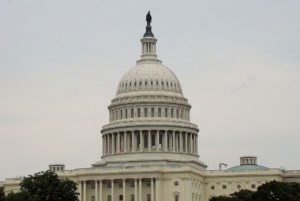 Democratic Members of the U.S. House of Representatives, led by Majority Whip James Clyburn (SC) and Energy and Commerce Committee Chairman Frank Pallone (NJ), yesterday announced the outline of a “Plan to Connect All Americans to Affordable Broadband Internet” that includes grant programs at the state and federal levels to promote broadband adoption and digital skills (i.e., the Digital Equity Act), as well as expanded funding and eligibility for “existing payment support for consumers” aimed at “helping low-income and recently unemployed Americans afford broadband” — probably meaning an emergency home broadband subsidy tied to the Lifeline program.
Democratic Members of the U.S. House of Representatives, led by Majority Whip James Clyburn (SC) and Energy and Commerce Committee Chairman Frank Pallone (NJ), yesterday announced the outline of a “Plan to Connect All Americans to Affordable Broadband Internet” that includes grant programs at the state and federal levels to promote broadband adoption and digital skills (i.e., the Digital Equity Act), as well as expanded funding and eligibility for “existing payment support for consumers” aimed at “helping low-income and recently unemployed Americans afford broadband” — probably meaning an emergency home broadband subsidy tied to the Lifeline program.
The thirteen-point Plan — whose other points range from $80 billion for broadband infrastructure investments to grant support for hotspot lending programs and school bus wi-fi — is among the major initiatives that House Democrats will seek to include in one or more new “pandemic response” stimulus packages, to be debated in the coming months.
NDIA Executive Director Angela Siefer praised the “Plan to Connect All Americans” as the first important legislative attempt by either political party to address the nation’s digital divide in a comprehensive way. “This Plan recognizes that we must address the barriers to broadband access and use – availability of infrastructure and the high cost of a broadband subscription through local solutions” Siefer said. “The gaps in digital access that the COVID-19 crisis has revealed in communities of all kinds, throughout the country, should persuade elected representatives of both parties that this approach is urgently needed.”
Majority Whip Clyburn, who also chairs the House Democratic Rural Broadband Task Force, and Congressman Pallone were joined in yesterday’s announcement by ten other members of the Task Force and the Energy and Commerce Committee: Representatives Mike Doyle (PA), Jerry McNerney (CA), Dave Loebsack (IA), Marc Veasey (TX), Anna Eshoo (CA), Peter Welch (VT), Ben Ray Luján (NM), Paul Tonko (NY), Grace Meng (NY), and Mark Pocan (WI).
Here’s the “Plan to Connect All Americans to Affordable Broadband Internet” as outlined yesterday:
Invest in Internet Infrastructure
-
-
- Deploy High-Speed Broadband – Invests $80 billion over five years to deploy secure and resilient broadband infrastructure to expand access for communities nationwide, connecting unserved and underserved rural, suburban, and urban areas across the country while prioritizing persistent poverty communities
- Offer Low-Interest Financing for Broadband Deployment – Invests $5 billion over five years for low-interest financing of broadband deployment through a new program that would allow eligible entities to apply for secured loans, lines of credit, or loan guarantees to finance broadband infrastructure build out projects
- Dig Once – Promotes the installation of broadband conduit during the construction of any road receiving federal funding to facilitate the building of broadband network infrastructure
- Invest Federal Funds Efficiently – Establishes the Office of Internet Connectivity and Growth within the National Telecommunications and Information Administration, responsible for coordinating with other federal agencies to streamline the application processes for broadband funding programs; ensure that broadband-related support is being administered in an efficient, technology-neutral, and financially sustainable manner; and track all federal money used for construction and use of broadband infrastructure
-
Ensure Internet Affordability
-
-
- Promote Competition – Gives preference in awarding funding to broadband builds that will provide open access to new infrastructure to allow additional providers to use taxpayer funded infrastructure on fair terms to provide more options to consumers
- Require an Affordable Option – Requires internet service providers whose networks are built with new federal funding to offer at least one affordable option
- Enhance Payment Support – Increases existing payment support for consumers, expands eligibility for and applicability of support, and eliminates barriers to helping low-income and recently unemployed Americans afford broadband access
- Protect Local Options – Guarantees the right of local governments, public-private partnerships, and cooperatives to deliver broadband service, which has lowered prices in many communities
- Gather Pricing Data – Directs the Federal Communications Commission to collect data on prices charged for broadband service throughout the country and make that data widely available with appropriate privacy protections
- Learn More Information – Directs the Office of Internet Connectivity and Growth to conduct a study on the extent to which cost remains a barrier to broadband adoption and the feasibility of providing additional targeted federal subsidies to offset costs for low-income households
-
Enable Internet Adoption
-
-
- Promoting Broadband Adoption and Digital Skills – Provides over $1 billion to establish the State Digital Equity Capacity Program, an annual grant program for states to create and implement comprehensive digital equity plans to help close gaps in broadband adoption and digital skills. Also establishes the Digital Equity Competitive Grant Program to further support these efforts through digital inclusion projects undertaken by individual organizations and local communities.
- Lend Mobile Hotspots – Provides for the rapid deployment of mobile hotspots and other internet-connected devices to enable students without internet at home to participate in remote learning and complete homework assignments requiring an internet connection
- Connect School Buses – Authorizes funding for Wi-Fi on school buses so that students can be connected, especially in rural areas where long bus rides are common
-
